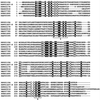Archaeal shikimate kinase, a new member of the GHMP-kinase family
- PMID: 11114929
- PMCID: PMC94878
- DOI: 10.1128/JB.183.1.292-300.2001
Archaeal shikimate kinase, a new member of the GHMP-kinase family
Abstract
Shikimate kinase (EC 2.7.1.71) is a committed enzyme in the seven-step biosynthesis of chorismate, a major precursor of aromatic amino acids and many other aromatic compounds. Genes for all enzymes of the chorismate pathway except shikimate kinase are found in archaeal genomes by sequence homology to their bacterial counterparts. In this study, a conserved archaeal gene (gi1500322 in Methanococcus jannaschii) was identified as the best candidate for the missing shikimate kinase gene by the analysis of chromosomal clustering of chorismate biosynthetic genes. The encoded hypothetical protein, with no sequence similarity to bacterial and eukaryotic shikimate kinases, is distantly related to homoserine kinases (EC 2.7.1.39) of the GHMP-kinase superfamily. The latter functionality in M. jannaschii is assigned to another gene (gi591748), in agreement with sequence similarity and chromosomal clustering analysis. Both archaeal proteins, overexpressed in Escherichia coli and purified to homogeneity, displayed activity of the predicted type, with steady-state kinetic parameters similar to those of the corresponding bacterial kinases: K(m,shikimate) = 414 +/- 33 microM, K(m,ATP) = 48 +/- 4 microM, and k(cat) = 57 +/- 2 s(-1) for the predicted shikimate kinase and K(m,homoserine) = 188 +/- 37 microM, K(m,ATP) = 101 +/- 7 microM, and k(cat) = 28 +/- 1 s(-1) for the homoserine kinase. No overlapping activity could be detected between shikimate kinase and homoserine kinase, both revealing a >1,000-fold preference for their own specific substrates. The case of archaeal shikimate kinase illustrates the efficacy of techniques based on reconstruction of metabolism from genomic data and analysis of gene clustering on chromosomes in finding missing genes.
Figures





Similar articles
-
Overexpression, purification, and characterization of the thermostable mevalonate kinase from Methanococcus jannaschii.Protein Expr Purif. 1999 Oct;17(1):33-40. doi: 10.1006/prep.1999.1106. Protein Expr Purif. 1999. PMID: 10497066
-
Identification of the gene encoding homoserine kinase from Arabidopsis thaliana and characterization of the recombinant enzyme derived from the gene.Arch Biochem Biophys. 1999 Dec 1;372(1):135-42. doi: 10.1006/abbi.1999.1481. Arch Biochem Biophys. 1999. PMID: 10562426
-
Structure of Methanocaldococcus jannaschii nucleoside kinase: an archaeal member of the ribokinase family.Acta Crystallogr D Biol Crystallogr. 2006 Sep;62(Pt 9):1085-97. doi: 10.1107/S0907444906024826. Epub 2006 Aug 19. Acta Crystallogr D Biol Crystallogr. 2006. PMID: 16929110
-
Shikimate kinase, a protein target for drug design.Curr Med Chem. 2014;21(5):592-604. doi: 10.2174/09298673113206660299. Curr Med Chem. 2014. PMID: 24164195 Review.
-
The shikimate pathway: review of amino acid sequence, function and three-dimensional structures of the enzymes.Crit Rev Microbiol. 2015 Jun;41(2):172-89. doi: 10.3109/1040841X.2013.813901. Epub 2013 Aug 6. Crit Rev Microbiol. 2015. PMID: 23919299 Review.
Cited by
-
Non-homologous isofunctional enzymes: a systematic analysis of alternative solutions in enzyme evolution.Biol Direct. 2010 Apr 30;5:31. doi: 10.1186/1745-6150-5-31. Biol Direct. 2010. PMID: 20433725 Free PMC article.
-
Identification and characterization of an archaeon-specific riboflavin kinase.J Bacteriol. 2008 Apr;190(7):2615-8. doi: 10.1128/JB.01900-07. Epub 2008 Feb 1. J Bacteriol. 2008. PMID: 18245297 Free PMC article.
-
Glutamine versus ammonia utilization in the NAD synthetase family.PLoS One. 2012;7(6):e39115. doi: 10.1371/journal.pone.0039115. Epub 2012 Jun 15. PLoS One. 2012. PMID: 22720044 Free PMC article.
-
Biosynthesis of ribose-5-phosphate and erythrose-4-phosphate in archaea: a phylogenetic analysis of archaeal genomes.Archaea. 2005 May;1(5):347-52. doi: 10.1155/2005/314760. Archaea. 2005. PMID: 15876568 Free PMC article.
-
Inhibitors of pantothenate kinase: novel antibiotics for staphylococcal infections.Antimicrob Agents Chemother. 2003 Jun;47(6):2051-5. doi: 10.1128/AAC.47.6.2051-2055.2003. Antimicrob Agents Chemother. 2003. PMID: 12760898 Free PMC article.
References
-
- Blattner F R, Plunkett III G, Bloch C A, Perna N T, Burland V, Riley M, Collado-Vides J, Glasner J D, Rode C K, Mayhew G F, Gregor J, Davis N W, Kirkpatrick H A, Goeden M A, Rose D J, Mau B, Shao Y. The complete genome sequence of Escherichia coli K-12. Science. 1997;277:1453–1474. - PubMed
-
- Bult C J, White O, Olsen G J, Zhou L, Fleischmann R D, Sutton G G, Blake J A, FitzGerald L M, Clayton R A, Gocayne J D, Kerlavage A R, Dougherty B A, Tomb J F, Adams M D, Reich C I, Overbeek R, Kirkness E F, Weinstock K G, Merrick J M, Glodek A, Scott J L, Geoghagen N S M, Venter J C. Complete genome sequence of the methanogenic archaeon, Methanococcus jannaschii. Science. 1996;273:1058–1073. - PubMed
-
- Cordwell S J. Microbial genomes and “missing” enzymes: redefining biochemical pathways. Arch Microbiol. 1999;172:269–279. - PubMed
-
- De Feyter R. Shikimate kinases from Escherichia coli K12. Methods Enzymol. 1987;142:355–361. - PubMed
MeSH terms
Substances
LinkOut - more resources
Full Text Sources
Molecular Biology Databases
Miscellaneous

